Ever tried making jewelry and found it too complicated? You’re not alone.
Many people find themselves struggling with intricate techniques, especially when it comes to wire wrapping gemstones.
It can feel overwhelming, but the good news is, with the right guidance, anyone can learn this beautiful art.
In this article, we’ll break down the process step-by-step, using clear and simple instructions.
By the end, you’ll be able to create stunning pieces of jewelry, even if you’re a complete beginner.
THIS POST MAY CONTAIN AFFILIATE SALES LINKS. PLEASE SEE MY FULL AFFILIATE DISCLOSURE FOR DETAILS.
How To Wire Wrap Gemstones?
Part 1: Determining Ideal Materials
Selecting the perfect gemstone and wire is crucial for a beautiful and durable design.
Ensure your chosen materials complement each other in both appearance and strength.
Step 1: Select Your Gemstone
The first step in wire wrapping gemstones is picking the right gemstone to be the centerpiece of your jewelry.
Whether you like the dark blue of lapis lazuli or the bright green of emerald, pick the one that suits your style or the taste of the person you’re making it for.
Make sure the gemstone is not too fragile, as you’ll be working with it closely, and you don’t want it to crack or chip during the process.
Also Read: 15 Best Crystal Combinations For Sunstone For Peace and Prosperity
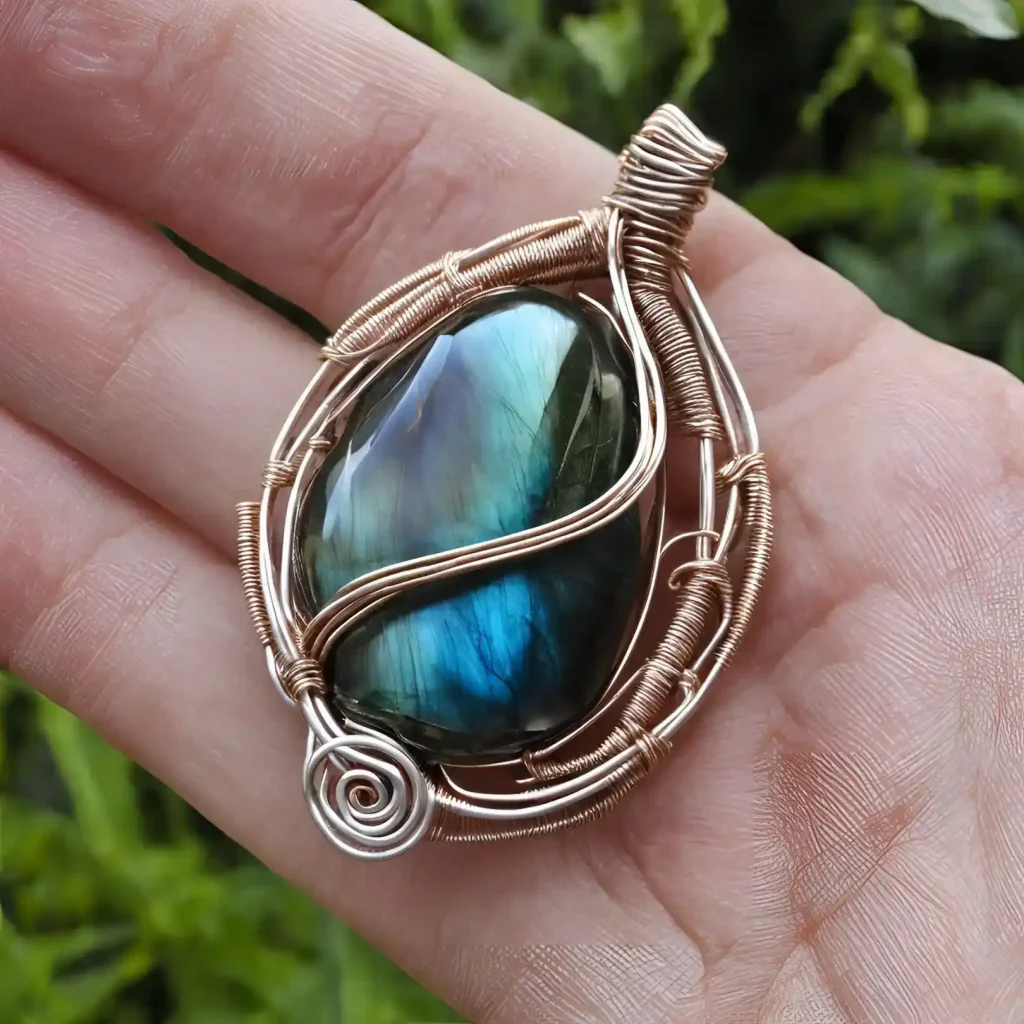
Step 2: Choose The Best Wire For Your Gemstone
After you’ve selected your gemstone, the next step is to choose the appropriate wire to wrap it.
Wires come in different materials and thicknesses (known as gauges), so you’ll need to choose one that complements your stone.
For instance, a delicate gemstone might look best with a thin, elegant wire, while a larger, bolder stone could pair well with a thicker wire.
Copper, silver, and gold are popular choices because they’re easy to work with and add a beautiful finish.
Consider the color of your gemstone when selecting the wire; the two should complement each other.
Step 3: Assemble Your Wire Wrapping Tools And Materials
Now that you’ve chosen your centerpiece and wire, it’s time to gather your tools and materials. You’ll need some basic tools to start:
- Wire cutters: They assist in snipping the wire to your desired length.
- Round-nose pliers: These help you make loops and bends in the wire.
- Flat-nose pliers: They help to hold the wire in place as you work.
- Ruler: It helps to measure your wire accurately.
- Tape: It aids in securing the wire temporarily, if needed.
Make sure you have everything you need on hand before you begin, so you won’t have to stop in the middle of your project to search for a missing tool.
Step 4: Set Up Your Work Area
Before you start wrapping, it’s important to set up a clean, well-lit workspace. This will help you focus and make the process much easier.
Choose a flat surface where your tools and supplies can be laid out within easy reach.
If you’re working with small gemstones, consider using a tray or mat with raised edges to prevent them from rolling away.
Good lighting is crucial, so position a lamp close by to clearly see what you’re doing.
Lastly, make sure your chair is comfortable and at the right height, so you can work without straining your back or neck.
Part 2: Forming The Wire Frame For Your Centerpiece
Once you’ve prepared your workspace and gathered all your supplies, it’s time to start forming the wire frame that will hold your gemstone securely.
This part of the process is where precision and attention to detail really come into play.
Follow these steps carefully to create a strong and attractive frame.
Also Read: Why Cant Carnelian And Amethyst Be Together?
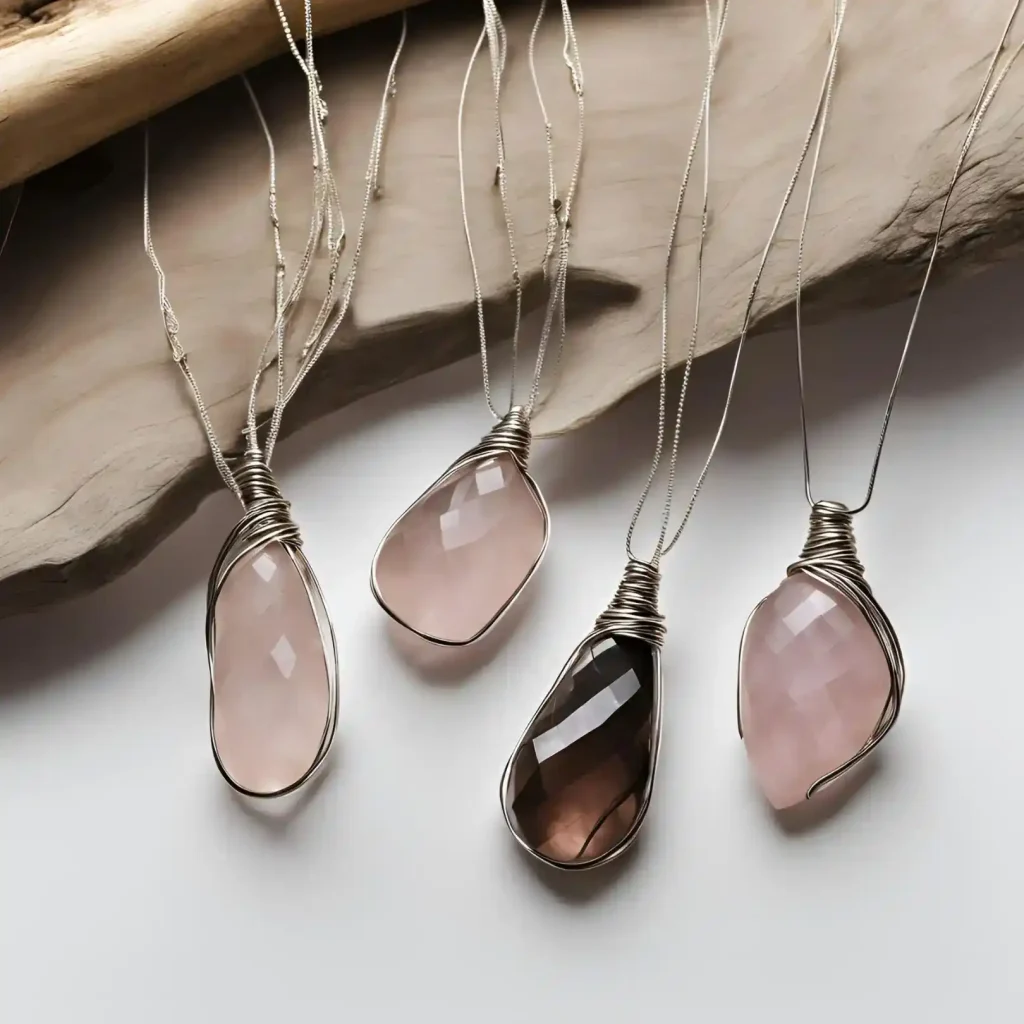
Step 1: Cut Equal-Length Wires For The Frame
Start by cutting the wires that will form the main structure of your frame. You’ll need several pieces of wire, all cut to the same length.
The exact number and length will depend on the size of your gemstone and the design you have in mind, but for beginners, six wires is a common choice.
Use your ruler to measure each piece accurately, ensuring they are all exactly the same length.
This consistency is key to creating a balanced and professional-looking frame.
Step 2: Bundle Your Cut Wires Together
Once you’ve cut all your wires, gather them together into a bundle. Align the ends carefully, so they sit flush with each other.
This step is crucial for maintaining even tension as you work, which will help your frame stay sturdy and symmetrical.
Step 3: Mark The Center Of Your Wire Bundle
Now that your wires are neatly bundled, find the middle point of the group. Use a pencil or fine-tip marker to draw a small line across the wires at this midpoint.
This line will serve as a guide for the next steps, helping you keep everything centered and balanced.
Step 4: Cut Your First Piece Of Binding Wire
Next, cut a shorter piece of wire that will be used to bind your bundle together at the middle mark you just made.
This binding wire should be thinner than your frame wires, as it needs to be flexible enough to wrap tightly around the bundle without adding too much bulk.
Measure and cut this wire to the appropriate length, usually about four to six inches, depending on the thickness of your frame wires.
Step 5: Secure The Bundle At The Midpoint
With your binding wire ready, place it over the middle mark on your bundle and begin wrapping it tightly around the wires.
Hold the bundle firmly as you wrap, making sure the wires stay aligned.
Wrap the binding wire several times around the bundle, pulling it snugly each time to ensure a secure hold.
Once it’s tightly bound, trim any excess binding wire and tuck the ends in neatly to avoid sharp edges.
Step 6: Mark Additional Binding Points
After securing the middle, you’ll need to create additional binding points along the length of your frame.
These will help keep the wires evenly spaced and stable as you shape the frame.
Rely on your ruler to measure equal distances from the center mark to where the next bindings will be placed.
Mark these spots lightly with your pencil or marker. The number of additional binding points will vary depending on the size of your gemstone and the design of the frame.
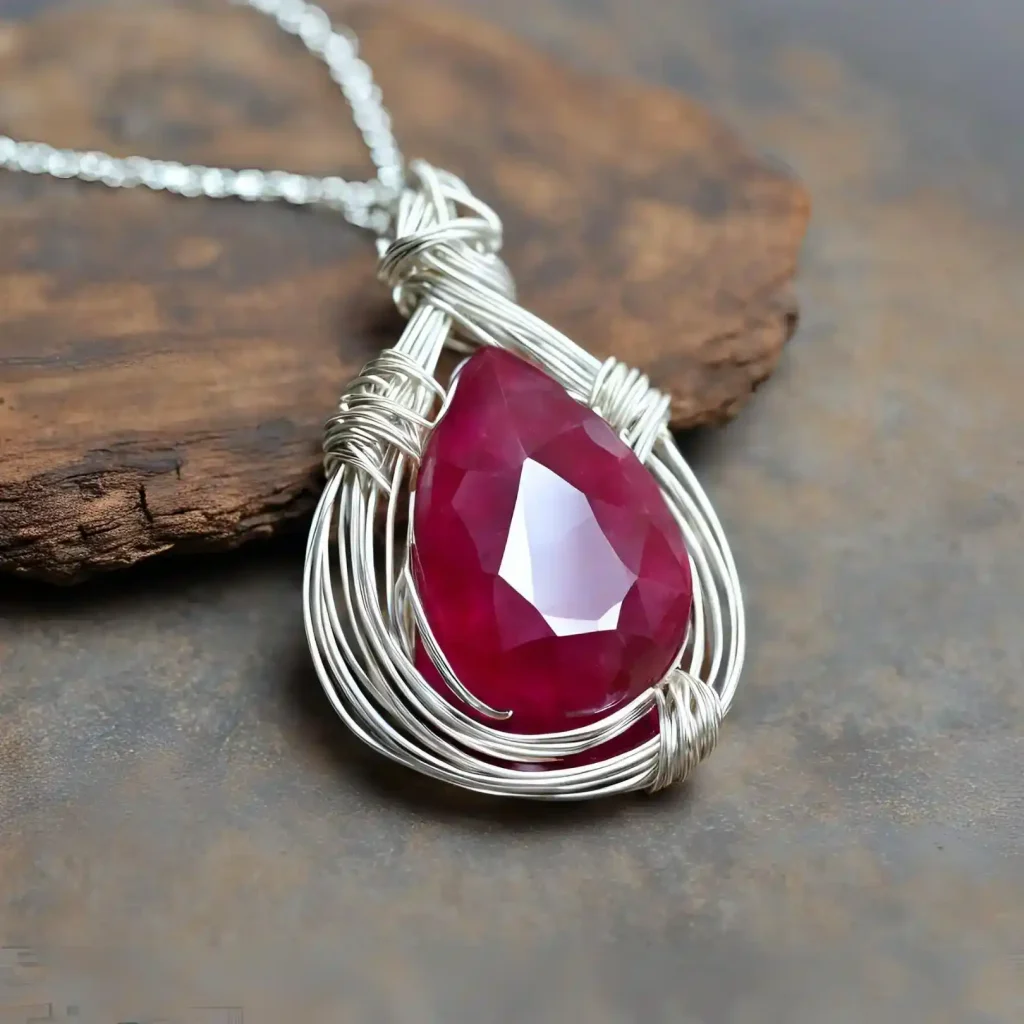
Step 7: Remove The Tape From The Wire Ends
Finally, if you used tape to hold the ends of your wire bundle together while you were binding the middle, now is the time to remove it.
Gently peel the tape off, being careful not to disturb the alignment of the wires.
Your bundle should now be secured in the middle and ready for the next steps in forming the frame around your gemstone.
Also Read: 36 Tigers Eye Combinations To Transform Your Life
Part 3: Shaping The Cradle For Your Centerpiece
With your wire frame partially constructed, the next step is to shape the cradle that will securely hold your gemstone.
This part of the process requires careful bending and binding to ensure your stone is well-supported.
Step 1: Shape The Cradle For Your Gemstone
Begin by gently bending the bundled wires to form a cradle that will fit around the base of your gemstone.
Use your hands or pliers to carefully shape the wire, making sure it curves evenly and symmetrically.
The goal is to create a snug seat for the gemstone, so take your time to ensure the cradle conforms closely to the shape of the stone without being too tight or too loose.
Step 2: Re-Tape The Ends Of The Wire Bundle
Once the cradle is shaped, it’s important to keep the ends of the wire bundle together as you continue working.
Reapply tape to the ends of the wires to prevent them from spreading apart.
This will help maintain the integrity of the shape you’ve just created and make the next steps easier to manage.
Step 3: Secure The Bundle With Additional Binding Wire
Next, take another piece of 22-gauge half-round wire to further secure your wire bundle.
Wrap this wire around the bundle at the spots you marked earlier, just below the edges of the cradle.
This additional binding will help hold the wires in place and add strength to the frame.
Make sure the wraps are tight and evenly spaced, giving your frame a neat and professional look.
Step 4: Finish The Base Of Your Gemstone’s Cradle
With the cradle’s shape and binding in place, you can now complete the base seating for your gemstone.
Adjust the wires as needed to ensure they form a stable and supportive base.
The cradle should hold the gemstone firmly, with enough space for the stone to sit comfortably without wobbling or slipping out of place.
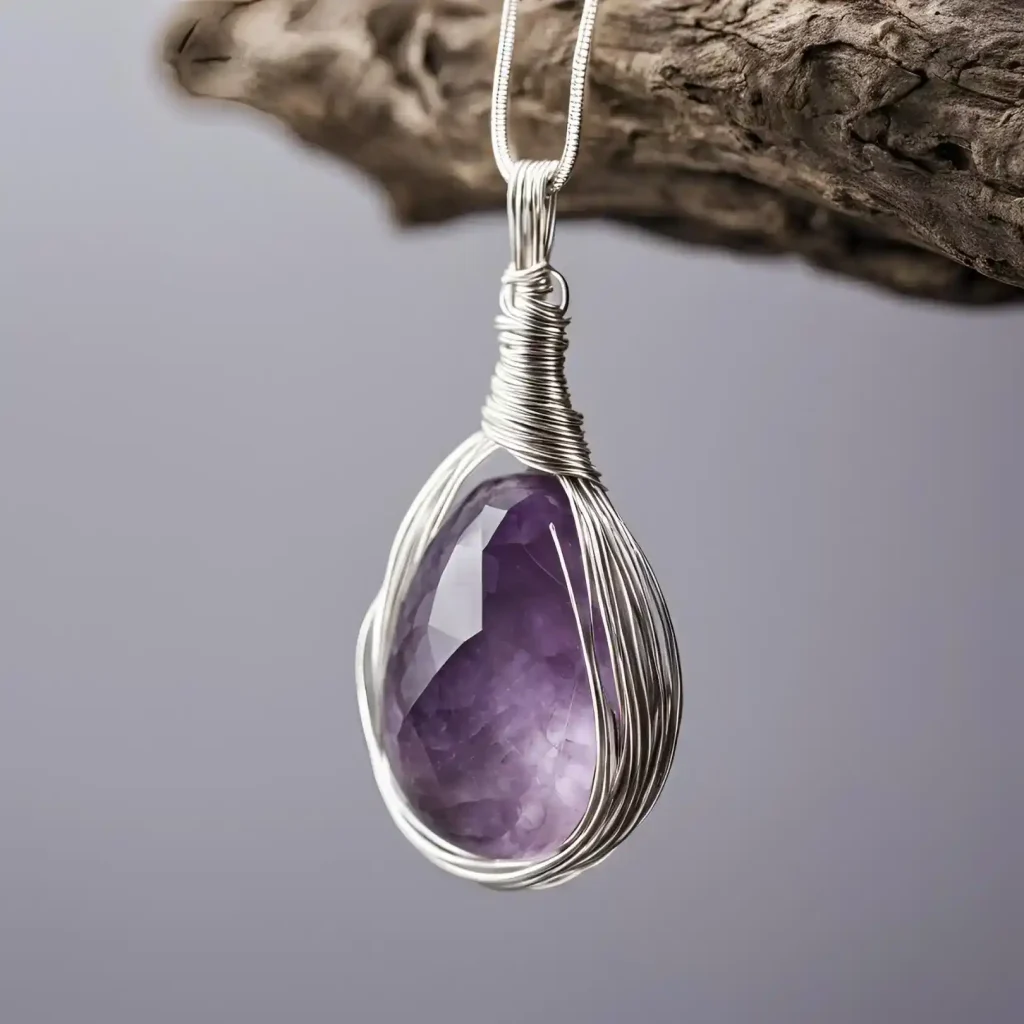
Step 5: Prepare The Front Support For Your Gemstone
Now, focus on creating the front support that will secure the gemstone from the top.
Carefully bend the front wires upward, shaping them so they contour around the front of the gemstone.
This will help lock the stone into the cradle and prevent it from moving.
The front support should be just tight enough to hold the stone securely without putting too much pressure on it.
Also Read: 23 Best Crystal Combinations For Selenite For Spiritual Growth
Step 6: Join The Ends Of The Wire Frame
After the front support is shaped, it’s time to bring the ends of your wire frame together.
Align the ends of the wire bundle so they meet evenly, and gently twist or bend them together to create a smooth connection.
This step helps to finalize the structure of the frame, ensuring it’s both secure and aesthetically pleasing.
Step 7: Tape The Wires Together
To keep everything in place as you continue working, tape the wire strands together where they meet.
This will hold the frame steady, making it easier to work on the finer details in the next steps.
The tape will also help you maintain the shape of the frame, ensuring your gemstone remains well-supported.
Part 4: Finishing Your Wire Wrap
In this final stage, you’ll secure your gemstone in place and add the finishing touches to your design.
These steps will ensure your wire wrap is both functional and beautiful.
Step 1: Create The Final Binding At The Top Of Your Piece
Commence by securing your wire wrap design’s top with a final binding.
Use a piece of your binding wire to wrap around the wires at the top, just above where your gemstone sits.
This final wrap will pull the frame together and hold the stone firmly in place.
Make sure the binding is tight and even, as this will be the main support that keeps your gemstone secure.
Step 2: Position Your Gemstone In The Wire Wrap
Now, carefully place your gemstone into the cradle you’ve created. Adjust the wires as needed to ensure the stone fits snugly.
The gemstone should sit securely within the frame, with the wires wrapping around it evenly.
Take your time to make any final adjustments to the positioning, as this is the last chance to perfect the fit before completing the wrap.
Also Read: 18 Powerful Blue Lace Agate Combinations That Define Your Aura
 Step 3: Trim Excess Wire
Step 3: Trim Excess Wire
Once your gemstone is seated properly, it’s time to cut off any excess wire.
Use your wire cutters to trim the wires down to a manageable length, leaving just enough to complete the final touches.
Be careful to cut neatly and avoid leaving sharp edges that could snag or scratch the wearer.
Step 4: Form A Loop At The Top Of Your Design
To finish off your wire wrap, bend one or two of the remaining wires at the top of your design to form a loop.
This loop will serve as the attachment point for a chain or cord, allowing your piece to be worn as a pendant.
Use your round-nose pliers to shape the loop, making sure it’s centered and secure.
If you have multiple wires left, you can either twist them together before forming the loop or use them to create decorative swirls or patterns around the top of your design.
What To Do If The Wire Isn’t Wrapping Neatly?
If the wire isn’t wrapping neatly, here are some steps you can take to improve the outcome:
- Check Wire Tension: Ensure you’re applying consistent tension while wrapping. If the wire is too loose or too tight, it can cause uneven wrapping. Adjust the tension as needed for a smooth wrap.
- Use the Right Tools: Make sure you’re using the appropriate tools for your wire. Round-nose pliers and flat-nose pliers can help manipulate the wire more precisely, while wire cutters should be sharp for clean cuts.
- Align Wires Properly: If you’re working with multiple wires, make sure they are aligned and bundled evenly before you start wrapping. Misalignment can lead to uneven wraps.
- Reposition the Wire: If you notice the wire isn’t laying flat, try repositioning it. Gently straighten and adjust the wire with your pliers to ensure it’s wrapping smoothly.
- Practice Consistency: Practice wrapping with a steady hand and consistent motion. If your wrapping is uneven, it could be due to inconsistent pressure or speed.
- Smooth Out Wrapping: If you see any lumps or bumps after wrapping, use your flat-nose pliers to gently smooth them out. Be careful not to over-compress, which can damage the wire or gemstone.
- Start Over if Necessary: If the wire wrapping is too uneven and can’t be corrected, it may be best to start over with a fresh piece of wire. Sometimes, a clean slate is the best way to ensure a neat and professional finish.
Also Read: The 11 Astonishing Benefits Of Wearing Hematite Bracelet
What To Do If The Gemstone Doesn’t Fit Perfectly?
If the gemstone doesn’t fit perfectly into your wire wrap design, try these solutions:
- Adjust the Cradle: Carefully reshape the cradle to better fit the gemstone. Use your pliers to bend the wires gently until the gemstone fits snugly. Ensure the adjustments are even to avoid putting uneven pressure on the stone.
- Add Padding: If the gemstone is slightly too small for the cradle, you can add padding. Use small pieces of felt or fabric to create a snug fit. Place the padding inside the cradle where the gemstone will sit to fill any gaps.
- Reposition the Gemstone: Sometimes, simply adjusting the position of the gemstone within the cradle can help. Make sure it’s centered and properly seated to see if that improves the fit.
- Modify the Wire Frame: If the gemstone is too large, you might need to adjust the size of the wire frame. Carefully bend and reshape the wires to accommodate the stone. This may involve undoing and reworking some of the bindings.
- Check for Obstructions: Ensure there are no obstructions or uneven wires preventing the gemstone from fitting correctly. Sometimes wires may overlap or be misaligned, causing the stone to not fit properly.
- Recreate the Design: If adjustments don’t work, consider starting over with a different wire frame design or adjusting the dimensions of the original frame. Ensure that you measure the gemstone accurately before creating the new frame.
- Use a Professional Tool: If you have access to a professional setting tool, use it to mold the frame more precisely. This can help create a perfect fit for the gemstone.
Also Read: Unveiling The Powerful Black And Red Bracelet Meaning
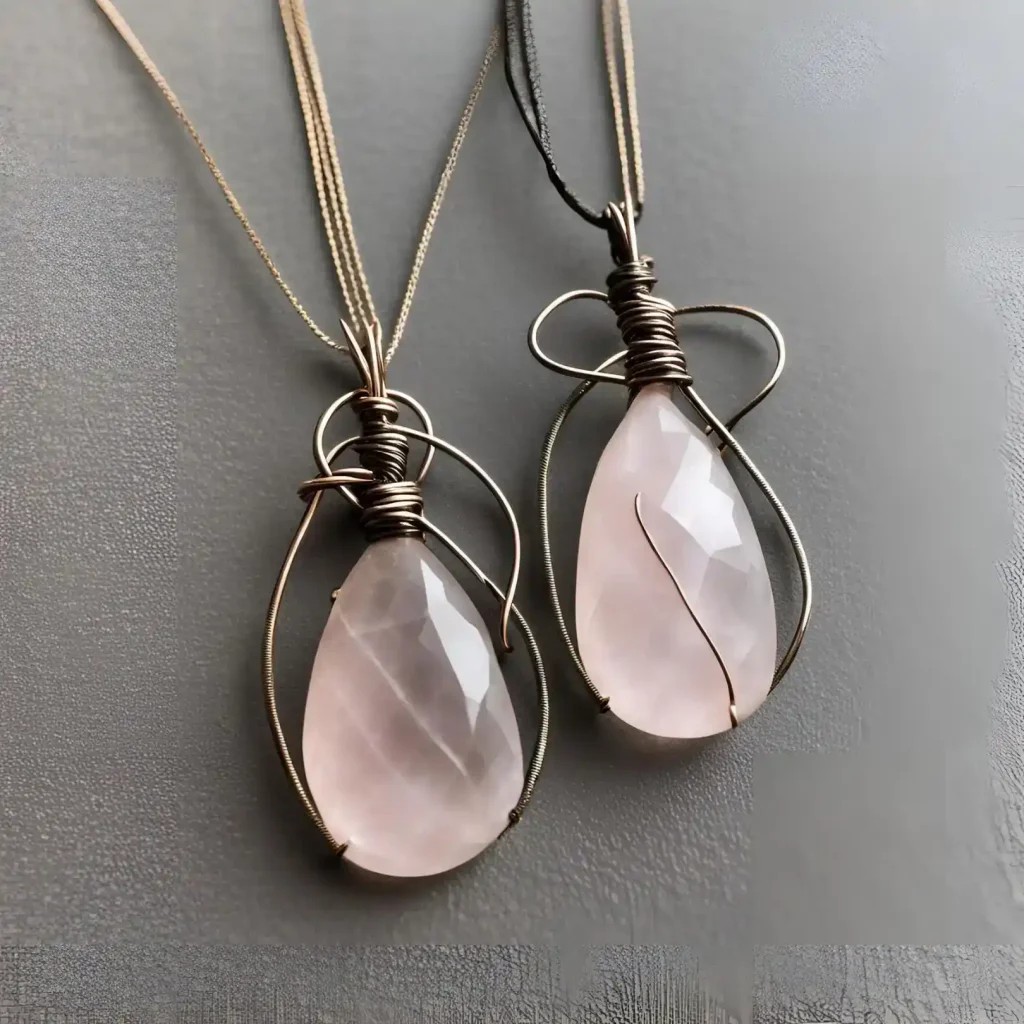
Final Thoughts
Wire wrapping gemstones may seem complex at first, but by breaking the process down into clear, manageable steps, it becomes a skill that anyone can learn.
From selecting the right gemstone and wire to shaping a secure cradle and adding the final decorative touches, each part of the process contributes to creating a beautiful and unique piece of jewelry.
With patience and practice, you’ll be able to craft stunning wire-wrapped designs that showcase the natural beauty of your chosen stones.

 Step 3: Trim Excess Wire
Step 3: Trim Excess Wire